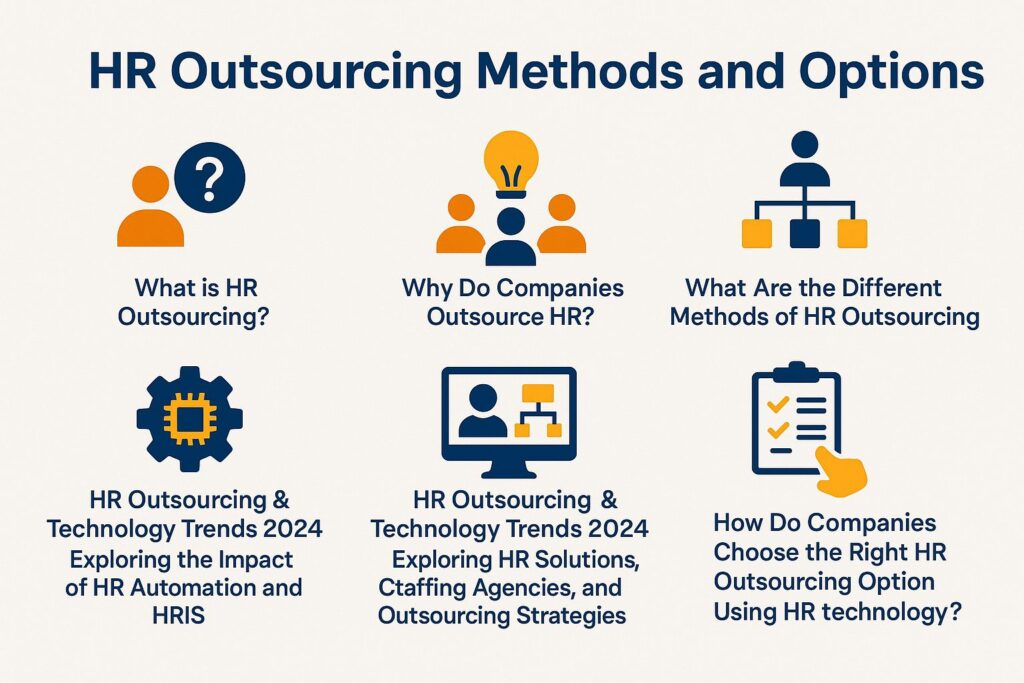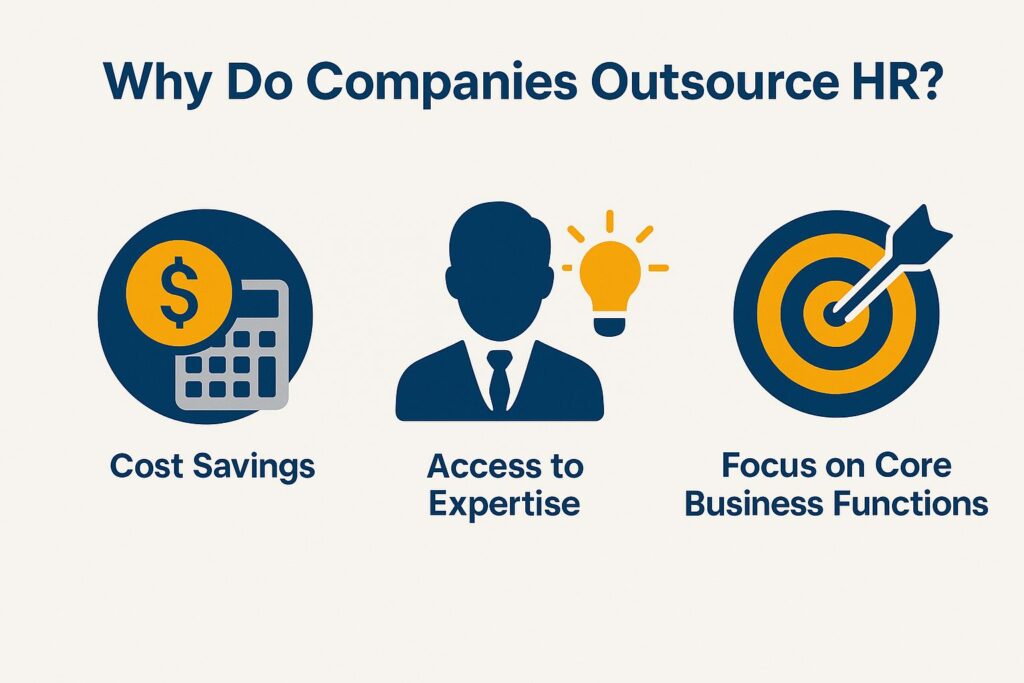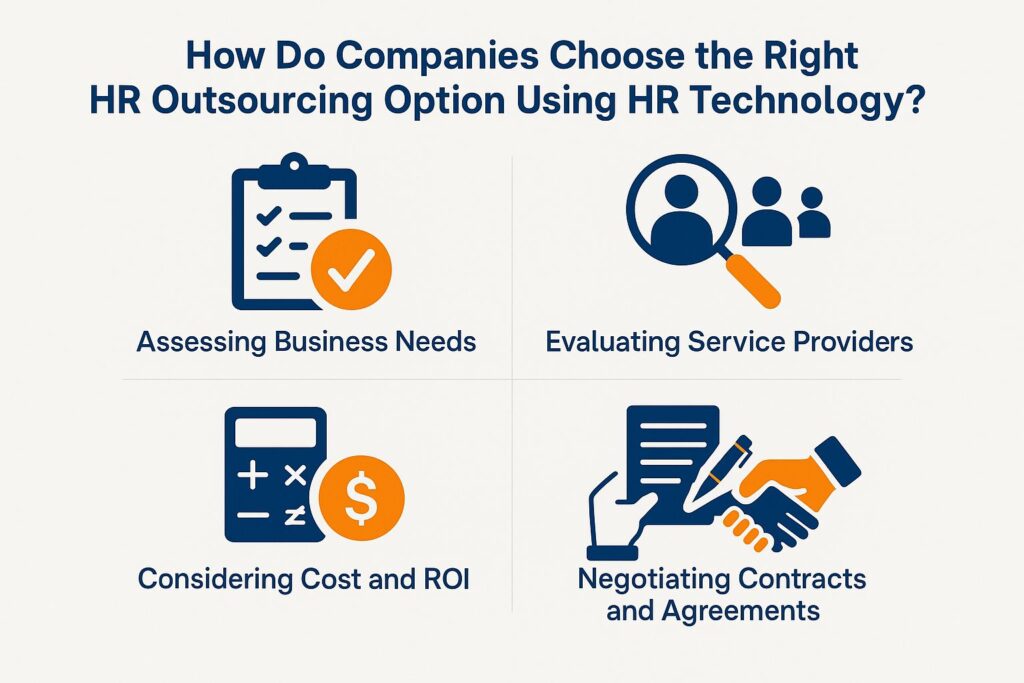
HR Outsourcing Methods And Options
In today’s fast-paced business environment, companies are increasingly turning to HR outsourcing and other HR solutions to simplify tasks and improve productivity.
This article explores what HR outsourcing entails, why organizations opt for it, and the various methods and options available.
From cost savings and access to specialized expertise to the ability to focus on core business functions and improve strategic alignment, the benefits are clear.
We will guide you through selecting the right HR outsourcing strategy and outsourcing models made specifically for your company’s unique needs.
This guide explains HR outsourcing methods for beginners or those looking to make their current process better. everyone.
What is HR Outsourcing?
HR outsourcing, or human resources outsourcing, is when companies give certain HR tasks to outside service providers. This includes tasks such as handling payroll, recruitment process, managing employee benefits, and helping new employees get started with effective onboarding, all aimed at improving how things run and cutting costs.
As businesses change, using outsourcing partners lets companies use advanced HR technology and cloud-based HR services, allowing them to concentrate on important HR plans and improve HR practices. If interested, you can explore how HR outsourcing specifically reduces costs by visiting our detailed analysis.
Why Do Companies Outsource HR?
Businesses choose to outsource HR to save on wages, benefit from expert skills, and allow their internal teams to focus on core tasks.
By partnering with HR service providers, companies can handle HR duties such as hiring, payroll, and outsourcing employee benefits more smoothly. This boosts productivity and helps the organization grow. This approach aligns with the principles outlined in our analysis of why strong HR management is crucial for business success.

1. Cost Savings
One of the primary benefits of HR outsourcing is cost savings; by outsourcing HR functions, companies can significantly reduce expenses associated with hiring, training, and maintaining an in-house HR team. This approach reduces costs and improves how well operations work by letting organizations use their resources in a better way, enhancing operational efficiency.
Along with decreasing staffing costs, businesses can also minimize technology investments, as outsourced HR providers often come equipped with advanced HR technologies that would otherwise require substantial upfront expenses.
Administrative overhead is typically lowered, as routine tasks such as payroll processing and employee record management are handled by specialists, freeing up internal staff to focus on strategic initiatives and business process outsourcing.
By simplifying these processes, companies can save a lot of money, improve HR service delivery, and also provide better service and follow compliance and legal regulations, which are important in today’s competitive market.
2. Access to Expertise
Using external companies for HR tasks allows businesses to work with experienced HR consultants and get information they might not have in-house. By collaborating with HR consultants and professional employer organizations (PEOs), businesses can gain from tried-and-true methods, knowledge in adhering to regulations, and new HR approaches that better manage talent according to their unique needs.
Working together makes processes simpler and improves how well HR management works.
HR consultants are very knowledgeable about complex rules and compliance matters, ensuring that organizations adhere to the frequently updated laws.
PEOs can help businesses expand and adjust easily as they grow, ensuring scalability and flexibility.
By tapping into these resources, companies can focus on their core activities while knowing that their HR processes are handled by professionals who prioritize industry standards, efficiency, and vendor performance.
This plan helps keep employees interested in their work and staying with the company, leading to ongoing success.
3. Focus on Core Business Functions
By outsourcing HR functions, companies can concentrate on their core business activities without being bogged down by administrative tasks. This change increases employee involvement and contributes to the company’s growth, allowing employees to focus on key projects that drive success and improve their participation.
As a result, employees can feel more encouraged and driven, knowing that their employers are focusing on important goals that affect their daily work life.
When companies outsource HR tasks, they allow room for new ideas, better workplace conditions, and growth in organizational development. This method sets up an adaptable setting where teams can work together to create a supportive workplace and draw in talented workers.
It helps leaders concentrate on long-term planning and solutions that can grow, ensuring lasting success and driving change management.
What Are The Different Methods Of HR Outsourcing?
Organizations have multiple ways to outsource their HR tasks, each with distinct advantages and functions, including international outsourcing and domestic outsourcing.
These outsourcing options include:
- Complete outsourcing, where an external provider handles all HR tasks, improving business continuity.
- Shared projects where company staff and external contractors work together to improve how resources are used.
- Outsourcing for specific HR projects.
These outsourcing methods can help companies align their HR plans with business goals effectively, ensuring strategic outsourcing. For an extensive analysis of this trend, our comprehensive study on cutting HR costs through outsourcing offers valuable insights into maximizing efficiency and savings.
HR Outsourcing & Technology Trends 2024: Exploring the Impact of HR Automation and HRIS


The HR Outsourcing & Technology Trends 2024 data highlights the growing adoption of HR outsourcing and HR solutions, including the integration of AI and automation in HR functions. This part of the report shares important information about the present and upcoming trends in the HR outsourcing market.
HR Outsourcing Statistics show that 80% of businesses outsource HR functions, driven by cost savings, workforce management, and efficiency. Specifically, companies report a 22% cost savings from outsourcing HR, which is significant for budget optimization. Satisfaction levels are high, with 78% of businesses satisfied with outsourcing costs and the same percentage meeting their cost goals. This indicates a general approval of outsourcing providers in meeting financial expectations.
In terms of specific HR functions, 54% of companies outsource recruitment, highlighting the need for specialized hiring processes, HR consultants, and access to wider talent pools. Additionally, 37% of companies outsource payroll, a function that benefits from accuracy and compliance managed by experts. However, only 11% report a reduction in staff due to outsourcing, suggesting that the primary aim is efficiency rather than workforce reduction.
The integration of AI and Automation in HR technology is another critical trend. 64% of HR professionals use AI to eliminate unqualified candidates, streamlining the recruitment process. Furthermore, 85% of employers use AI to save time and improve efficiency Automation greatly improves HR tasks. A noteworthy 66% of CEOs believe AI can improve HR functions, and a substantial 92% of HR leaders plan to use AI for talent acquisition, showing strong trust in AI’s ability to improve HR tasks.
In terms of Market Projections, the HR outsourcing market is projected to reach a value of $65.3 billion by 2030, reflecting the need for remote HR services and nearshoring solutions. This growth is driven by the increasing complexity of HR tasks and the need for cost-effective solutions. Also, the market for AI in HR is predicted to increase by 35.26% between 2022 and 2027, indicating a rapid adoption of AI technologies in HR practices.
Overall, the HR Outsourcing & Technology Trends 2024 data illustrates the significant impact of outsourcing and technology on the HR industry. Businesses are using outsourcing to save money and work faster, while AI and automation are changing HR tasks to be simpler and more productive. These trends will likely keep influencing human resources, encouraging progress and new ideas in the field.
1. Full-Service Outsourcing
Full-service outsourcing involves handing over all HR tasks to an outside company, which then manages the HR operations and employee relations. This covers all aspects from hiring, payroll, and handling employee issues to following rules and managing benefits, helping companies simplify their vendor management and concentrate on their main business plans.
By assigning these important tasks to a specialist, organizations can operate more smoothly, reduce their running expenses, improve staff management, and focus on HR service delivery.
Full-service outsourcing encompasses a variety of HR functions such as:
- Talent acquisition and job outsourcing
- Performance management
- Training and development
- Regulatory compliance
This lets internal teams concentrate on other tasks like HR compliance audits while making sure current industry standards and practices are consistently followed, resulting in an adaptable and fast HR environment.
As businesses look to adjust to a fast-paced market, outsourcing these key tasks helps grow and bring new ideas, which leads to a more involved and efficient team.
2. Co-Managed Services
Co-managed services represent a hybrid approach to HR outsourcing, where both the internal HR team and an external provider work collaboratively to manage HR functions. This model lets organizations manage specific HR tasks while getting help and resources from their outsourcing partners.
By using the strengths of both groups, businesses can make their HR setting more flexible and quick to respond. This partnership allows internal teams to concentrate on essential work, while trusting external experts for tasks like managing payroll or hiring staff.
Working together allows easy use of new HR tools, improving work efficiency and meeting changing rules. In the end, working together improves how things run and helps internal teams focus more on strategy within the company.
3. Project-Based Outsourcing
Project-based outsourcing involves contracting external HR consultants to manage specific HR projects, such as talent acquisition or performance management initiatives. This method lets companies use specific skills for certain projects without needing long-term outsourcing agreements.
Using this plan, companies can quickly handle urgent HR requirements and continue concentrating on their main activities.
Project-based outsourcing allows for better use of resources and brings in the right people to tackle difficult tasks.
For instance, tapping into industry experts for a brief period can lead to innovative solutions that an in-house team may not readily provide. Using outside experts helps share knowledge, supporting growth within the team.
Including project-based outsourcing in HR plans helps the company be more flexible and prepared for changes.
What Are The Options For HR Outsourcing and HR innovation?
When thinking about HR outsourcing, companies can choose from many services that meet various HR needs.
Popular choices include:
- Recruitment process outsourcing (RPO)
- Payroll outsourcing and HR automation
- Benefits administration outsourcing
- Compliance and risk management outsourcing
These outsourcing services help businesses handle HR tasks effectively while following labor laws and improving work processes.

1. Recruitment Process Outsourcing (RPO)
Recruitment process outsourcing (RPO) involves hiring an external company to manage some or all recruitment tasks. This supports businesses in improving their hiring choices by using HR data and performance metrics. RPO providers manage recruitment, improve the company’s image, and communicate with candidates to attract skilled employees.
With the help of RPO specialists, companies can make their hiring process more efficient while keeping a positive image that connects with potential hires.
This partnership leads to better interaction with candidates, creating a stronger group of potential hires and speeding up the hiring process.
RPO solutions can give useful information about market trends and how candidates act, helping organizations match their hiring plans with their overall HR goals.
In the end, this can result in better hires who match the job and fit well with the company’s culture, which improves overall retention rates.
2. Payroll Outsourcing
Payroll outsourcing involves transferring the management of payroll processing to an external vendor, relieving companies of the complex and time-consuming task of payroll administration, allowing for effective cost analysis. This makes sure the company follows labor laws and lets them concentrate on important HR tasks and outsourcing employee benefits.
Hiring experts for this important task reduces mistakes, addresses outsourcing challenges, and makes the process more efficient by using the skills of payroll specialists.
Vendors typically stay up-to-date with the latest regulations and tax changes, ensuring that businesses meet compliance requirements with minimal effort.
By delegating payroll responsibilities, companies can allocate their internal resources towards strategic initiatives such as talent acquisition, training programs, and employee engagement.
This flexibility results in a workforce that can quickly respond to changing market conditions.
3. Benefits Administration Outsourcing
Benefits administration outsourcing is the process of delegating the management of employee benefits programs to external providers, ensuring effective administration of health, retirement, and other benefits. This option makes HR compliance easier and also improves employee satisfaction and involvement.
By giving these tasks to specialized companies, organizations can make their processes more efficient, allowing internal HR teams to focus on important projects instead of dealing with complicated regulatory requirements.
Outsourcing can improve employee experiences by offering more choices and clear information about their benefits, enhancing employee satisfaction, which can lead to higher participation in programs.
When employees feel supported and informed about their benefits, their overall job satisfaction increases, contributing to a more motivated and productive workforce.
Outsourcing benefits administration reduces the workload and helps build a positive company culture.
4. Training and Development Outsourcing
Training and development outsourcing involves using outside companies to improve employee training sessions, skill assessment, and evaluation efforts. By hiring expert trainers, companies can make sure their employees keep learning new skills, which results in improved management and happier staff.
This plan reduces the workload on internal teams and introduces new ideas and skills that might not be available within the company.
Outsourcing training pinpoints areas where employees need improvement by thoroughly assessing their skills, aiding in HR practices and HR policies, allowing programs to be customized to fit their particular needs.
Organizations see improved skills, higher morale, stronger connection with company values, and more involvement, encouraging ongoing learning.
Investing time and money in professional growth can greatly improve the organization’s progress, helping it remain competitive in the constantly shifting market.
5. Compliance and Risk Management Outsourcing
Outsourcing compliance and risk management means hiring outside companies to make sure HR practices follow labor laws and rules. This lowers the chance of not following regulations and improves HR risk management, enabling companies to concentrate on main tasks.
By giving these important tasks to the right people, organizations can better protect themselves from possible legal issues that may come from poorly handled compliance activities, making sure HR compliance audits are thorough and performance reviews are regular.
These external experts provide specialized knowledge and up-to-date information about labor laws and market trends, while also making processes easier, which are often complicated and lengthy.
Outsourcing this aspect of operations can lead to cost savings and improved organizational efficiency, as businesses can allocate resources more effectively through HR service delivery and HR automation.
Outsourcing improves transparency, guards against unexpected risks, and allows for a quicker response to changes in regulations.
How Do Companies Choose The Right HR Outsourcing Option Using HR technology?
Picking the best HR outsourcing choice means organizations need to carefully look at their business needs, check out possible service providers through vendor selection, and think about aspects like cost and how much they will gain from the investment. When considering software solutions, top HR management softwares can help streamline these processes.
Good contract negotiation is important to make sure the chosen outsourcing option matches the organization’s goals and how it operates.

1. Assessing Business Needs
Evaluating business requirements is important when thinking about HR outsourcing, as it helps companies figure out which HR tasks could use outside help. This process involves evaluating current HR capabilities, workforce management challenges, and strategic HR outsourcing goals.
By closely examining these parts, businesses can understand how well they are working and where they can get better. Knowing what an organization needs helps them identify tasks that might be handled better by outside companies, like handling payroll, hiring new staff, or running training programs for employees.
This evaluation helps in making good decisions, ensuring that the chosen HR outsourcing options align with long-term business goals, support growth, and promote a more adaptable and efficient workforce. Spending time on this review reduces risks and improves the organization’s performance.
2. Evaluating Service Providers
Once business needs are identified, evaluating service providers becomes essential in the HR outsourcing process. Organizations should evaluate potential HR service providers by considering their skills, experience in the field, and how well they meet specific workforce management requirements.
It’s important to look at things like how technology is included, reaction speed, and following rules when picking the best partner.
Carefully choosing vendors helps make sure the selected provider can handle today’s needs and is prepared for any growth and changes that might happen in the industry later.
Examining how their solutions can expand and how they manage employee involvement and happiness will lead to better decisions. This will lead to a partnership that aligns with organizational goals and creates a positive work environment.
3. Considering Cost and ROI
When choosing HR outsourcing options, it is essential to consider cost and return on investment (ROI) thoroughly. A detailed financial analysis can help organizations understand the long-term benefits of outsourcing, including cost reduction and improved operational efficiency.
By closely examining these financial metrics, businesses can identify which outsourcing partners align best with their strategic goals. This review is essential because errors in predicting ROI can result in spending too much or services not meeting expectations, which can hurt business operations.
Knowing how outsourcing HR can save money, reduce paperwork, and improve rule-following can make it a good choice. Organizations can grow over time and manage workers better by making decisions based on thorough financial evaluations.
4. Negotiating Contracts and Agreements
Negotiating contracts and agreements is a critical step in the HR outsourcing process, ensuring that both parties understand their responsibilities and expectations. This includes detailing service level agreements (SLAs) that specify performance measures and compliance needs for effective outsourcing partnerships.
For successful negotiations, make sure to clearly talk about pricing details, delivery schedules, project timelines, and how to handle possible conflicts.
It is essential for the parties involved to agree on the key performance indicators (KPIs) that will measure success and track results.
Including flexibility in the contract can help manage possible changes in business needs, project scope, or market conditions, allowing both parties to adjust while protecting their interests.
Good agreements make things easier and help people work together, resulting in success and satisfaction for all parties involved.
About the Author
Ellen Westbrook is a Stanford University graduate with a bachelor’s degree in human resources and psychology. She’s the owner of a successful HR and payroll outsourcing firm in Colorado and a contributing writer for HR Costs. With 17 years of experience, Ellen helps businesses reduce risk, manage HR more efficiently, and grow with confidence.

